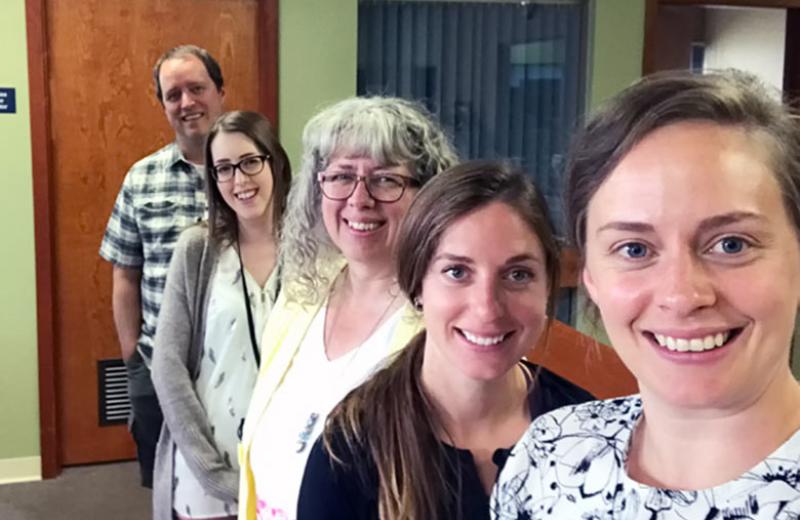Over the last couple of years, the primary health care team in Smithers has been struggling to get to a point where they have a complete number of staff. Today, we’re happy to say that all primary care nurse (PCN) positions are full!
What is a primary health care team and what’s the latest on the Smithers team?
A primary health care team is composed of nurses, social workers, physiotherapists and occupational therapists, dietitians, a diabetes educator, and other professionals who work together to support patients in the community.
Out of the 11 full-time and part-time staff who make up the PCNs on the Smithers primary health care team, only three team members have worked on the team for more than 18 months. That means that 72% of the team are new staff. Right now, there are two casual employees that are in permanent positions, and only one of them has been in Smithers longer than 18 months. The team has hired nine casual PCNs over the last 18 months and nearly all of them have become permanent employees or are in temporary positions.
PCNs and primary health care are pretty new… what’s happening with training?
I spoke with Sandra Stanley, Team Lead for the Smithers primary health care team, to find out how she’s cross training the new staff.
“The ‘how we did it’ is partially the people that are here. They’re amazing people – intelligent, kind, compassionate, and motivated to give great care,” says Sandra.
When Sandra started as the Team Lead, many skilled staff had left and new staff members were struggling. They needed support to provide the full range of expected services. Smithers faced many challenges getting to this point, but they now have a stable team and good morale.
“I believe now, from talking with nurses, that the morale has improved, and they have become a tight and supportive team that work really well together, and genuinely like each other,” says Sandra. “They’ve picked up the education with enthusiasm and [they’ve] been keen learners. They’re intelligent, compassionate, and good critical thinkers. I count myself as fortunate to be leading such a team and the credit for what I see as success is due in very large part to them and their excellent qualities.”
Sandra believes that, wherever possible, a key to training is modeling the skill for others. Along with “walking the talk,” here’s how the Smithers team is tackling training for different aspects of their roles:
Palliative care
Palliative care is a “way of being” with people. It requires nurses to have the ability to assess the state people are in emotionally and spiritually, as well as physically. It can't all be taught in a classroom. The skills are learned through experience, and being with other nurses who can mentor those skills. It was important to Sandra to pair less experienced nurses with others who have strong palliative care skills. The team was fortunate to have a primary care nurse with strong palliative care skills come back and join the team after moving away to work elsewhere. This was a game changer in many respects and helped provide that knowledgeable, consistent presence the nurses needed.
Long-term care needs assessment
Sandra’s team is focused on training related to completing the resident assessment instrument (RAI), which a requirement for a patient to go on a wait list for long-term care. With more primary care nurses using the RAI, people are assessed as needing long-term care and put on a wait list earlier. The team’s health care aides supports community members until they are ready to transition to a long-term care home. Health care aides are an essential part of a community program and are critical to supporting patients who are at home, waiting to enter a long-term care home.
Diabetes education services
After the diabetes educator in Smithers had to decrease workload, waitlists for service were longer than usual. In response, two nurses are training to help educate new diabetics to give insulin, manage blood sugars, and decide what to do when the sugars are high or low. There’s been an incredible amount of training and cross-training done in general, as well as new diabetes work taken on by the nurses due to the back log of diabetes referrals.
Mental health services
To support mental health patients in Smithers, there are cognitive behavioural therapy groups that include members of the primary health care team. These teams teach people with mental health issues how to cook, shop, bank, take care of themselves, and more. The other team lead in Smithers, Cynthia Rondeau, works very hard to ensure there is quality mental health support for clients.
Cross-community support
When the team has struggled, they’ve received help from Hazelton and Houston, and they helped those communities in return. These three communities are working well together and being generous when it comes to helping wherever they can.
“The better connected we are with the people in the community, the better we can prevent admissions to the hospital and visits to the ER that are unnecessary,” says Sandra.
Sandra’s work, helping her team learn and grow as primary care nurses, has been instrumental to providing Smithers with skilled health care professionals.














Comments